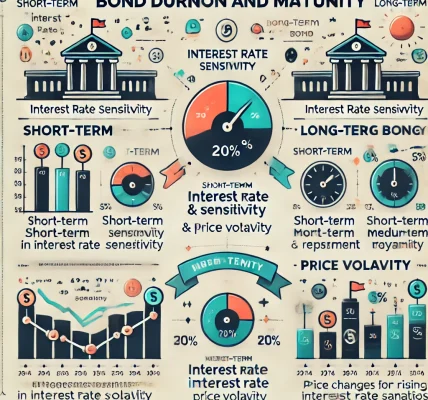Introduction
Bonds are often considered a safe and steady investment, making them a popular choice for conservative investors. However, like all investments, bonds come with their own set of risks. While bonds generally provide predictable income and lower volatility compared to stocks, it’s crucial for investors to understand the risks involved before adding them to their portfolios.
In this blog, we will dive deep into the different risks associated with bond investing, helping you make informed decisions and manage your bond investments effectively. Whether you’re a beginner or an experienced investor, understanding these risks can guide you in mitigating potential losses and maximizing returns from your bond investments.
What Are Bonds?
Before we delve into the risks, let’s briefly define what bonds are. Bonds are fixed-income securities issued by governments, municipalities, or corporations. When you invest in bonds, you are essentially lending money to the issuer in exchange for regular interest payments, known as the coupon, and the return of your principal when the bond matures.
While bonds can be an essential part of a diversified investment portfolio, they carry various risks that investors must carefully assess. Let’s explore these risks in detail.
1. Interest Rate Risk
One of the most significant risks associated with bonds is interest rate risk. When interest rates rise, the value of existing bonds typically falls. This is because newly issued bonds offer higher yields, making older bonds with lower rates less attractive.
For example, if you hold a bond with a 3% coupon and interest rates rise to 4%, your bond will decrease in value because investors can now buy newer bonds offering the higher 4% rate.
- How to Manage: To mitigate interest rate risk, you can consider holding bonds until maturity. This way, you won’t be affected by market fluctuations in bond prices. Alternatively, investors may diversify their bond portfolio by including bonds with varying maturities and interest rates.
2. Credit Risk (Default Risk)
Credit risk, also known as default risk, refers to the possibility that the bond issuer will be unable to make interest payments or return the principal at maturity. This risk is more prevalent in corporate bonds, especially those from companies with lower credit ratings, but it can also affect government bonds under certain circumstances.
- How to Manage: To minimize credit risk, consider investing in bonds with higher credit ratings from reliable agencies such as Moody’s, Standard & Poor’s, or Fitch. Government bonds from stable, economically sound countries are generally considered lower-risk investments.
3. Inflation Risk
Inflation risk, also known as purchasing power risk, is the risk that inflation will erode the purchasing power of the bond’s future interest payments and principal. If inflation rises, the real value of the bond’s fixed interest payments declines. This means that over time, the bondholder will be able to buy less with the same amount of money.
- How to Manage: To protect against inflation risk, investors can consider inflation-protected bonds such as Treasury Inflation-Protected Securities (TIPS). These bonds are designed to adjust their interest payments based on the inflation rate, helping to preserve purchasing power.
4. Reinvestment Risk
Reinvestment risk occurs when bondholders are unable to reinvest their coupon payments or the principal repayment at the same yield or interest rate as their original bond investment. This risk is more prominent in a declining interest rate environment, where investors may not be able to reinvest at attractive rates.
- How to Manage: To manage reinvestment risk, investors can consider long-term bonds with fixed rates, which help lock in a higher rate for a longer period. Additionally, creating a laddered bond strategy—where bonds with different maturities are held—can help reduce the impact of reinvestment risk.
5. Liquidity Risk
Liquidity risk refers to the risk that an investor may not be able to buy or sell a bond quickly without impacting its price. This is especially true for bonds with low trading volumes, such as bonds issued by smaller companies or municipal bonds.
- How to Manage: To mitigate liquidity risk, investors should focus on buying bonds that are widely traded or held by large issuers. Larger issuers, such as government bonds, tend to have more liquidity, making them easier to sell in the market if needed.
6. Call Risk
Call risk is the risk that a bond issuer will decide to redeem (call) the bond before its maturity date. Issuers may choose to call bonds if interest rates decline, allowing them to refinance at a lower cost. While this can be beneficial to the issuer, it may not always be favorable to bondholders, as they lose out on the expected future interest payments.
- How to Manage: To manage call risk, investors can look for non-callable bonds or bonds with longer maturity periods. Additionally, if you are considering callable bonds, it’s essential to understand the call provisions and the likelihood that the issuer will call the bond early.
7. Event Risk
Event risk is the possibility that unforeseen events, such as mergers, acquisitions, or regulatory changes, could affect the bond issuer’s ability to make timely payments or impact the bond’s market value. For example, a company undergoing a merger might face financial strain, which could lead to missed bond payments.
- How to Manage: Investors can stay informed about the financial health of the bond issuer and monitor news for any developments that may impact the company or government entity. Conducting thorough research before buying bonds can help reduce exposure to event risk.
8. Currency Risk (Foreign Bonds)
Currency risk applies to investors who buy bonds issued in a foreign currency. If the value of the foreign currency falls relative to the investor’s home currency, the returns from the bond can be negatively impacted, even if the bond itself performs well.
- How to Manage: Currency risk can be managed by diversifying your bond portfolio across different currencies or by using currency-hedged bond funds. However, hedging strategies may involve additional costs.
Conclusion
While bonds can be an essential part of a diversified portfolio, they are not without their risks. Understanding the various risks—interest rate risk, credit risk, inflation risk, reinvestment risk, liquidity risk, call risk, event risk, and currency risk—can help you make informed decisions and tailor your bond investments to meet your financial goals.
To mitigate these risks, consider diversifying your bond portfolio, focusing on high-quality issuers, and understanding the market conditions that may impact bond prices. By doing so, you can enhance the stability of your investment portfolio while managing potential risks effectively.




